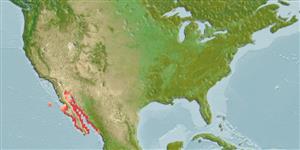>
Perciformes/Serranoidei (Groupers) >
Epinephelidae (Groupers)
Etymology: Mycteroperca: Greek, mykter, -eros = nose + Greek, perke = perch (Ref. 45335).
Eponymy: Dr David Starr Jordan (1851–1931) was a leading American ichthyologist, physician, educator, peace activist and believer in eugenics; moreover, he was founding President of Stanford University. [...] (Ref. 128868), visit book page.
More on authors: Jenkins & Evermann.
Environment: milieu / climate zone / depth range / distribution range
ນິເວດວິທະຍາ
ສັດທະເລ ກ່ຽວກັນຫີນ; ລະດັບຄວາມເລິກ 5 - 30 m (Ref. 9342). Subtropical; 33°N - 23°N, 119°W - 106°W (Ref. 5222)
Eastern Central Pacific: southern La Jolla, California, USA to Mazatlan, Mexico.
ຂະໜາດ / ນ້ຳໜັກ / Age
Maturity: Lm ? range ? - ? cm
Max length : 198 cm TL ຕົວຜູ້/ບໍ່ມີເພດ; (Ref. 2850); ນ້ຳໜັກສູງສຸດທີ່ເຄຍຈັດພີມມາ: 91.0 kg (Ref. 5222)
ຄີ (ໜາມ)ແຂງຢູ່ຫຼັງປາ (ທັງໝົດ) : 11; ຄີຫຼັງຂອງປາ (ຄີອ່ອນ) (ທັງໝົດ) : 16 - 17; ຄີ(ໜາມ) ແຂງຢູ່ຄີກົ້ນປາ
ກຸ່ມປາກະດູກແຂງ
ຄວາມຖີ່ຂອງກຸ່ມຖ່າຍທອດພັນ
ປາທີ່ມີການເຄື່ອນຍ້າຍຈາກທະເລໄປຫານ້ຳຈືດ ແລະນ້ຳຈືດຫາທະເລ
ປາທີ່ມີການເຄື່ອນຍ້າຍຈາກທະເລແລະໄປໄຂ່ຢູ່ນ້ຳຈືດ
ຄີກົ້ນຂອງປາ
ສັດທີ່ມີກະດູກສັນຫັຼງ
ການຖ່າຍທອດທາງກຳມະພັນຈາກພໍ່ແມ່ຫາລູກ: 3; ຄີກົ້ນຂອງປາ: 10 - 11. Distinguished by the following characteristics: uniform dark brown or grey color of adults (can rapidly change into juvenile pattern when disturbed or under stress), large adults with white pectoral fin margin and median fins with narrow white edge; juvenile with greyish brown color, with dark spots along upper half of the body; depth of body 3.1-3.4 times in SL; head length 2.5-2.7 times in SL; rounded preopercle, finely serrate, lacking distinct lobe at the angle; posterior nostrils not notably enlarged, diameter less than twice of anterior nostrils (Ref. 89707).
Found in rocky reefs and kelp beds. Juveniles are unknown in California waters and the few large adults that have been taken there are probably expatriates from a more southerly breeding population. Large adults feed on fishes (Ref. 9342). Reported to prey on juvenile hammerhead sharks. Its large size makes it an object of game fishing (Ref. 9342).
Life cycle and mating behavior
ການຈະເລີນເຕັມໄວ | ການສືບພັນ | ການວາງໄຂ່ | ໄຂ່ | ຄວາມດົກຂອງໄຂ່ປາ | ຕົວອ່ອນ
Heemstra, P.C. and J.E. Randall, 1993. FAO Species Catalogue. Vol. 16. Groupers of the world (family Serranidae, subfamily Epinephelinae). An annotated and illustrated catalogue of the grouper, rockcod, hind, coral grouper and lyretail species known to date. Rome: FAO. FAO Fish. Synop. 125(16):382 p. (Ref. 5222)
IUCN Red List Status (Ref. 130435: Version 2024-2)
Threat to humans
Harmless
Human uses
ການປະມົງ: ທີ່ເປັນການຄ້າໜ້ອຍ; ຊະນິດປາທີ່ຖືກນຳໃຊ້ເຂົ້າໃນການຫາເພື່ອເປັນເກມກິລາ: ແມ່ນ
ເຄື່ອງມື
Special reports
Download XML
ແຫຼ່ງອີນເຕີເນັດ
Estimates based on models
Preferred temperature (Ref.
123201): 18.6 - 25.9, mean 23 °C (based on 102 cells).
Phylogenetic diversity index (Ref.
82804): PD
50 = 0.5000 [Uniqueness, from 0.5 = low to 2.0 = high].
Bayesian length-weight: a=0.00933 (0.00426 - 0.02047), b=3.05 (2.88 - 3.22), in cm total length, based on LWR estimates for this Genus-body shape (Ref.
93245).
ຊັ້ນເຂດຮ້ອນ (Ref.
69278): 4.5 ±0.80 se; based on food items.
ຄວາມຢືດຢຸ່ນ (Ref.
120179): ຕຳ່ຫຼາຍ, ປະຊາກອນຕຳ່ສຸດທີ່ໃຊ້ເວລາສອງເທົ່າຫຼາຍກວ່າ 14 ປີ (Preliminary K or Fecundity.).
Fishing Vulnerability (Ref.
59153): Very high vulnerability (90 of 100).
Nutrients (Ref.
124155): Calcium = 8.75 [4.91, 18.12] mg/100g; Iron = 0.397 [0.198, 0.722] mg/100g; Protein = 19.5 [17.7, 21.3] %; Omega3 = 0.163 [0.086, 0.304] g/100g; Selenium = 19.6 [7.2, 42.9] μg/100g; VitaminA = 50.7 [13.8, 195.3] μg/100g; Zinc = 0.454 [0.295, 0.715] mg/100g (wet weight);
